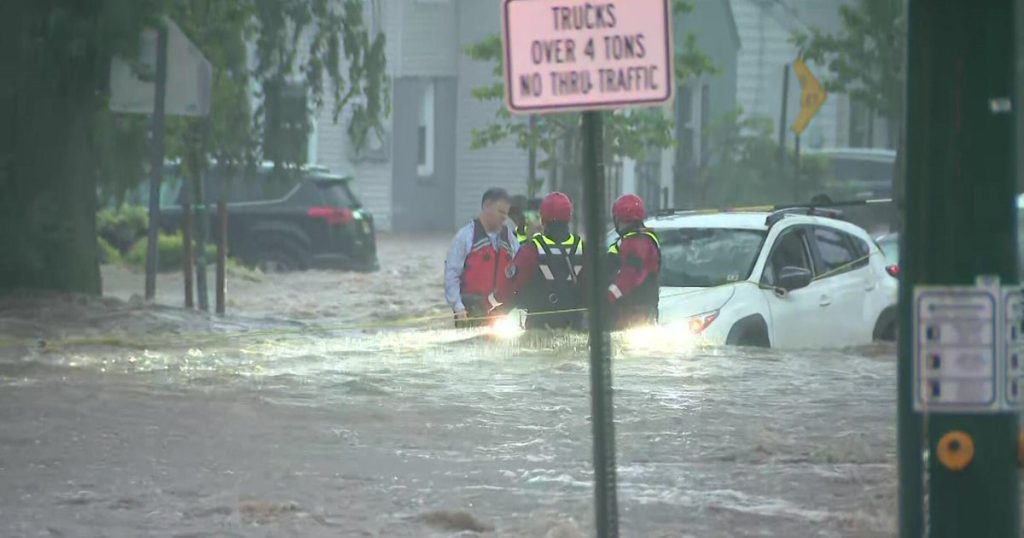Severe storms prompted flash flood warnings throughout the New York City metropolitan area on Monday night, leading to substantial flooding across urban zones in New York and parts of New Jersey. The deluge resulted in stalled vehicles, compromised public transit, and a state of emergency declaration by New Jersey officials. Residents are urged to exercise caution as ongoing rain exacerbates the flood conditions.
| Article Subheadings |
|---|
| 1) Overview of the Storm and Impacts |
| 2) Public Transit Disruptions in New York City |
| 3) Conditions in New Jersey |
| 4) Rescue Operations Underway |
| 5) Areas Most Affected and Recovery Efforts |
Overview of the Storm and Impacts
Heavy rainfall swept across the New York City metropolitan area, beginning Monday evening, which caused widespread flooding and swift river rises. The National Weather Service had issued flash flood warnings lasting until approximately 10 p.m. These alerts signified immediate threats to life and property, as flooding rapidly intensified in various neighborhoods. According to initial estimates, some areas received as much as six inches of rain by 8 p.m., compounding the concerns of local officials and emergency responders.
The New York City metropolitan area often faces severe weather during summer months, but recent extreme events have led many to question the effectiveness of current infrastructure in managing such deluges. Flash flood watches extended throughout the region late into the evening, revealing a dire scenario for residents unprepared for sudden inundations.
Public Transit Disruptions in New York City
Public transit, a critical lifeline for millions of commuters, was severely affected by the flooding. The Metropolitan Transportation Authority reported extensive delays particularly on subway lines due to water accumulating at multiple stations. Particularly impacted areas included stations in Manhattan, where drain backs and flooding on the platform led to service interruptions.
Images from the 28th Street subway station depicted torrents of water cascading from a drain, requiring urgent interventions to clear platforms for safety. Meanwhile, the Grand Central Terminal faced similar challenges as Metro-North Railroad services saw significant delays, effectively stranding commuters during peak travel hours. Officials stressed the importance of avoiding unnecessary travel until subway operations could stabilize.
Conditions in New Jersey
The storm did not spare New Jersey, where Governor Phil Murphy declared a state of emergency in light of deteriorating conditions. Reports from various municipalities indicated that roads were gridlocked with water, effectively rendering them impassable. In Scotch Plains, waters rose particularly high, causing widespread disruptions and prompting emergency alerts for residents to evacuate problematic areas.
One notable incident involved multiple vehicles—including ambulances and commercial trucks—that were ensnared by floodwaters on Main Street, resulting in dramatic rescues captured by local news outlets. Images and videos flooded social media, showcasing the surreal conditions transpiring just outside residents’ homes.
Rescue Operations Underway
Emergency responders moved swiftly to address the needs of those trapped or in distress due to the unprecedented weather. Reports confirmed at least one rescue operation initiated in Scotch Plains, where a team utilized a front loader to aid individuals stranded amidst the surging waters. Emergency officials highlighted that while challenges were significant, safety remained the top priority.
There was an overwhelming influx of 911 calls related to the flooding. Emergency services personnel worked in tandem with local fire departments to conduct evacuations, as mounting reports from Westchester County indicated similar scenarios. “Folks are being rescued, they are being taken out of those cars, and so far everyone has been safe,” stated County Executive Ken Jenkins, assuring residents of ongoing support.
Areas Most Affected and Recovery Efforts
In addition to urban elements, suburban and rural areas felt the brunt of the storm’s fury. Streets transformed into rivers in communities like Plainfield, where some homes faced dangerous flooding, while local businesses struggled with foot-deep inundations. Reports from Roselle Park indicated that businesses steadily lost revenue as a return to normalcy appeared bleak in the immediate aftermath of the storm.
Looking towards recovery, communities are assessing damage and calculating next steps for rebuilding. Business owner Russell Olden, who operates Dowling’s Irish Pub & Restaurant, lamented, “Unfortunately, we got hit again. We were hit four years ago with Ida. We invested money into the town, we wanted to stay here and unfortunately this is what we got.” Such sentiments echo throughout affected neighborhoods, as residents raise concerns about resiliency to future storms.
| No. | Key Points |
|---|---|
| 1 | Severe storms led to flash flood warnings in the New York metropolitan area. |
| 2 | Public transit disruptions occurred, with significant flooding impacting subway services. |
| 3 | New Jersey officials declared a state of emergency due to severe flooding. |
| 4 | Emergency rescue operations were initiated for stranded individuals. |
| 5 | Communities faced severe property damage and uncertainty regarding recovery efforts. |
Summary
The recent storms have underscored the vulnerabilities of infrastructure amidst severe weather conditions, impacting both urban and suburban areas. As emergency services continue their operations, a community-wide dialogue is likely to emerge regarding preparedness for similar events in the future. The road to recovery will be long, requiring concerted efforts from both public officials and the citizens they serve.
Frequently Asked Questions
Question: What caused the flooding in the New York metropolitan area?
The flooding was primarily caused by heavy and persistent rain brought on by severe storms, with reports estimating over six inches of rainfall accumulated in certain locales.
Question: How are local officials responding to the situation?
Local officials have declared states of emergency, coordinated rescue operations, and are assessing the damage to determine necessary recovery measures.
Question: What should residents do during severe weather alerts?
Residents are advised to remain indoors during severe weather, refrain from unnecessary travel, and stay informed through local resources regarding updates and safety announcements.


